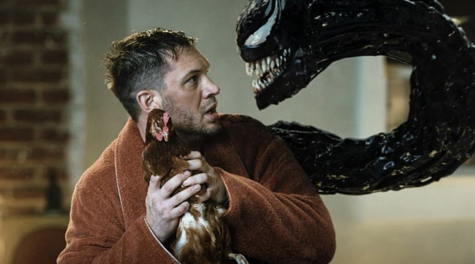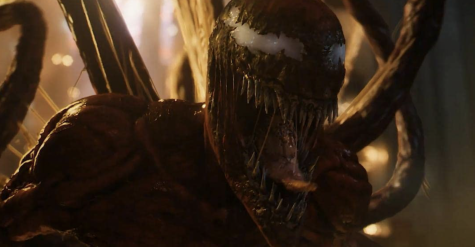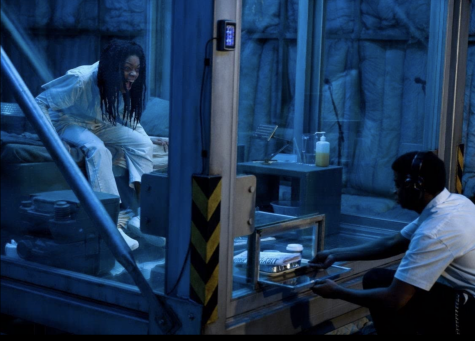REVIEW: “Venom: Let There Be Carnage’ embraces the comedy of its predecessor and delivers a fast-paced adventure
Sony’s “Venom” franchise stands out as an outlier for not being officially included in the Marvel Cinematic Universe. Despite its initial disconnection from Spider-Man, “Venom” is noted for its action, humor and Tom Hardy’s performance. Directed by character actor Andy Serkis, “Venom: Let There Be Carnage” indulges in the comedic tone of its predecessor and introduces new characters and elements to the franchise, but does it so hastily to the point where the film feels more like a short interlude rather than a major installment.
The film revisits journalist Eddie Brock (Tom Hardy) as he adjusts to living with and being the host to Venom, the alien symbiote. To reinvigorate his journalist career, Eddie interviews and investigates imprisoned serial killer Cletus Kasady (Woody Harrelson) for details of his victims. With investigation help from Venom, Eddie is able to uncover evidence that leads to Kasady’s execution. Due to a mistake on Eddie’s part, Kasady gains his very own symbiote known as Carnage. This leads to Kasady going on a murderous rampage to free his superpowered lover Frances Barrison (Naomie Harris) and take revenge on Eddie for condemning him. Consequently, Eddie finds himself as the suspect in a police investigation led by headstrong detective Patrick Mulligan (Stephen Graham) while he deals with being separated from Venom and moving on from his soon-to-be-married ex-girlfriend (Michelle Williams).

As with the first film, the sequel can be viewed as a superhero buddy-comedy. The crux of the two films is the relationship between Eddie and Venom, particularly their dependence on one another. Given the duo’s dark and eerie relationship in the comics, one might expect their bond to be more along those lines, instead of the comedic connection between the two. Viewers who enjoy the duo’s dynamic in the first film will thoroughly enjoy the aspect in this film, as Venom is featured more often than before and in some of the most bizarre contexts.
Although the sequel retains the first film’s humorous aspects, Carnage’s introduction generates a darker tone. Comic book readers are aware that Carnage is a vile and maniacally violent villain in the mainstream Marvel comics; he is depicted as a sadistic serial killer with little to no redeeming qualities, and he’s considered to be one of the most horrific villains in the Spider-Man mythos. Without heading into R-rated territory, the film manages to show the character’s horrific nature and his tendency to brutally kill others with his powers.

The movie counterpart is mostly accurate to the comics’ version, though he does receive an emotional weight through his comic-accurate love interest Frances, known as the villain Shriek in the comics. Some might think that having a love interest could take away from the horrifying nature of Carnage, but her inclusion adds another dimension to Kasady and dismisses the notion of him being a one-dimensional serial killer. However, some of the dialogue between the two can feel campy and melodramatic as it’s being delivered. Kasady loses some of his intimidation factor as a result.
The 97 minute runtime may not be satisfying to viewers who expect more content from the sequel. The short runtime is surprising in comparison to other superhero films, such as its predecessor, that tend to last closer to 2 hours or more. Though in such a short time, the film provides viewers with a plot that feels tight-knit and self-contained, there are certain points where it appears that scenes or context are missing. The most notable instance of this is in Carnage’s prison rampage scene. Where a shot shows him escaping an execution chamber to chase after the prison warden. But there’s barely any chase scene, as the scene cuts to Carnage immediately catching up with the warden in a cell block. A longer chase would have been beneficial to properly add tension and build up Carnage’s appearance, as opposed to a rushed escape sequence.

There is also enough visual spectacle and action to please fans. The fight scenes feature the most CGI and many that are featured show the symbiotes fighting against humans while demonstrating formidable monstrous strength. Some viewers may find these fights insignificant, but they build up to the big finale of Venom vs. Carnage. Each respective fight scene of the character tells much about them. Venom’s desire to devour his opponents is tamed by the morality and humanity of Eddie as his host, whereas Carnage demonstrates terrifyingly overwhelming abilities with a sadistic bloodlust that happens to match the desires of Kasady. The fight scenes say much about the characters as they build anticipation to a high-stake final battle.
The “Venom” films are a great opportunity for Hardy to display his leading man capabilities in a blockbuster franchise. Hardy generates charisma and an everyman quality to Eddie that’s refreshing in comparison to the obnoxious depictions seen in TV shows and Topher Grace’s performance in Spider-Man 3. Hardy’s best moments shine through in the instances of bizarre situational comedy, where Brock finds himself bickering or fighting with Venom. In also voicing Venom, Hardy melds his comedic chops with his signature voice alterations, to create a depiction of the character that’s both adorable and complimentary of his monstrous nature.

In what is arguably the most important performance of the film, given it is the character’s live-action debut, Harrelson exudes menace and dark humor as Carnage. Harrelson brings eeriness and fascination to the character that is strongly accurate of his comic counterpart. With comedic timing and an underlying ominous tone, Harrelson makes each line of spoken dialogue memorable and sound fitting to the character, no matter how cheesy some of them sound. Harrelson’s Carnage doesn’t reach the highs of nuanced supervillain portrayals like Heath Ledger’s Joker, but his performance is worthy enough to serve as a counterweight to Hardy’s Venom and create a balance between the two stars.
“Venom: Let There Be Carnage” expands upon the first film in many ways and points to the possibilities of where the franchise can go next, specifically in its mid-credits sequence. The film may not boast the urgency or ever-growing cultural significance of MCU films, but it offers fun entertainment for viewers nonetheless.










